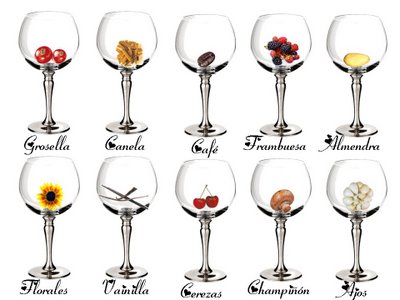Arômes du Vin
Les arômes sont une partie essentielle de la jouissance de tout aliment, et il est nez normal de nous fournir des indices à savoir si le vin va aimer ou pas. Le sens évocateur que nous possédons, c'est le sens de l'odorat, de sorte qu'un parfum léger, nous pouvons passer à des lieux et des temps passés. L'odorat est le sens que plus nous nous relions à notre vie privée, mais aussi le moins développé et mis en service, il est nécessaire d'activer notre mémoire émotionnelle, les souvenirs, pour décrire un vin qui peut dire «ceci vin a un arôme qui me rappelle ... ».
 And anyone can develop our paying attention to smell the smells of everyday, ie paying attention to the smells of flowers, fruits, ... but the problem is not being used to smell to memorize, we get aromas of context and find it difficult to detect in the wine. This is a fundamental part of the training of wine tasting, recognize aromas, and is nothing more than an exercise in memorization.
And anyone can develop our paying attention to smell the smells of everyday, ie paying attention to the smells of flowers, fruits, ... but the problem is not being used to smell to memorize, we get aromas of context and find it difficult to detect in the wine. This is a fundamental part of the training of wine tasting, recognize aromas, and is nothing more than an exercise in memorization.
In wine there are many smells, so many as we are able to perceive, and many more and even more modest wines can find flavors that seem wonderful. Depending on the quality of wine intervene greater or lesser number of flavorings may have great wines twenty detectable flavors, and all good.
Also indicate that we can find some undesirable odors in wines that are not preserved well or have the required quality. Among the negative scents can cite: cork, sulfur, block, rotten eggs, rubber, vinegar, ...
When a wine tasted different reactions occur through our senses. And all of them (sight, smell, taste, touch), give us some information about the product they are tasting. But it is the sense of smell which is more surprising and mysterious. The smells cause us emotional reactions long before we can express with words.
All flavors that can be found in our glass of wine can be classified according to their origin in:
Primary or varietal aromas: These are provided by the grape variety itself (found mostly in the skin, terpene in nature), and soil, crop type, etc.. They are essential in a good wine should always appear, unable to be covered by raising or processing. They tend to be either
Fruit (apple, pear, plum, lemon, orange, pineapple, banana, grapefruit, passion fruit, melon, mango, strawberry, raspberry, currant, cherry, blueberry, peach, apricot, ...).
Floral (acacia, honeysuckle vine flower, lily, broom, rose, lily, iris, violet, jasmine, agavanzo, orange blossom, heliotrope, ...).
Plant (pepper, lettuce, cabbage, cauliflower, asparagus, celery, ...).
Mineral (flint rifle stone, flint, lime, chalk ...).
Secundary Aromas: they are those of the fermentation (alcoholic and malolactic) and depend on the preparation and cleanup process. They are usually esters of fatty acids such as acetic acid and vinegar smell. In short, aldehydes and alcohols from the transformation of yeasts.
Tertiary aromas or "bouquet" of wine: They are in the process of aging and flavorings are often provided by the wood of the barrel: roasted, cloves, vanilla, cedar, pencil, resin, pine, ..., or by time spent in the bottle before consumption: leather wet, sweaty smell, snuff, cedar ...
Young wines will consist of only primary and secondary aromas and old wines are inundated with tertiary odors.
Now that you know how to identify wine aromas, enjoy playing. There is nothing like coming home after a hard day, get comfortable on your couch, listening to good music, and inspire deep inside a glass of wine to discover its aromas ...







